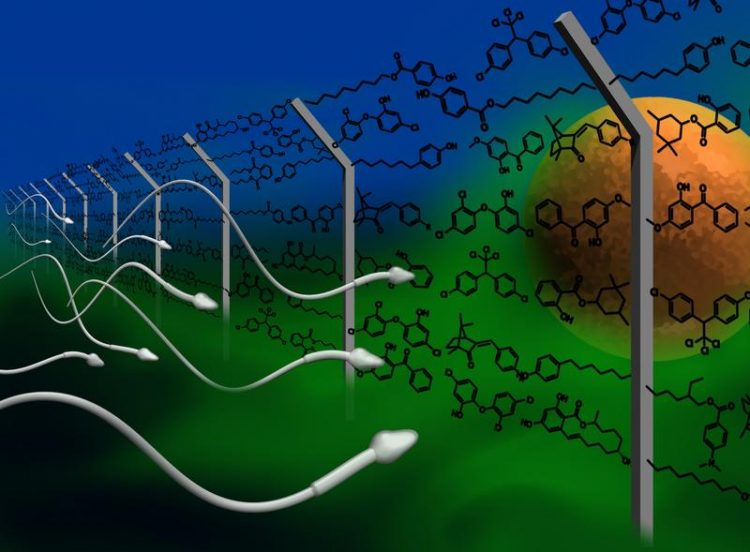Study elucidates the mechanism underlying “Cocktail Effects” of endocrine disrupting chemicals

Cocktails of endocrine disrupting chemicals affect the function of human sperm, which might interfere with the fertilization process Image: R. Pascal, Caesar, Bonn
Endocrine disrupting chemicals, omnipresent in food, plastics, textiles, and cosmetics, might be involved in fertility disorders, which are on the rise in the Western world. The chemicals impair the function of human sperm. They mimic the action of female hormones that control the swimming behavior of the sperm in the oviduct. Thereby, the chemicals could interfere with the fertilization process.
Scientists around Prof. Timo Strünker from the Centre of Reproductive Medicine and Andrology (CeRA, University of Münster, Germany) and Prof. Niels Erik Skakkebæk from the Rigshospitalet, Copenhagen (Denmark) have now taken another, closer look at the chemical´s action in sperm; in particular, at the so-called cocktail effect.
In our daily life, we incorporate a complex mixture of various endocrine disruptors – each individual chemical, however, only in a very low, rather ineffective concentration. Despite the miniscule concentrations of the individual components, cocktails of endocrine disruptors, such as those found in blood, have a pronounced action in sperm.
“The results of our new study can be easily summarized,” says Dr. Christoph Brenker from the CeRA, head of the study: “If the chemicals teams up in cocktails, their individual actions do not simply add up, but amplify each other.
In pharmacology, this phenomenon is called “synergism”: one plus one does not make two, but three! The researchers found that also the female hormones have a synergistic action in sperm. “The endocrine disruptors just imitate the female hormones – including their synergistic interaction,” said Brenker.
Whether the use of endocrine disrupting chemicals should be further restricted is a much debated question. The new results are important for assessing their toxic action: so far, “safety limits” are determined only for each chemical individually.
Considering that in cocktails, the actions of individual chemicals become amplified, such an isolated risk assessment is prone to underestimate the risk potential of endocrine disrupters. In fact, synergistic actions of endocrine disruptors have also been observed in other cells and tissues.
Media contact:
Dr. Thomas Bauer
Telefon: 0251 83-58937
E-Mail: thbauer@uni-muenster.de
Brenker C. et al.: Synergistic activation of CatSper Ca2+ channels in human sperm by oviductal ligands and endocrine disrupting chemicals. Human Reproduction 2018 Sep 5; doi: 10.1093/humrep/dey275 (Epub ahead of print)
Media Contact
More Information:
https://www.uni-muenster.de/All latest news from the category: Life Sciences and Chemistry
Articles and reports from the Life Sciences and chemistry area deal with applied and basic research into modern biology, chemistry and human medicine.
Valuable information can be found on a range of life sciences fields including bacteriology, biochemistry, bionics, bioinformatics, biophysics, biotechnology, genetics, geobotany, human biology, marine biology, microbiology, molecular biology, cellular biology, zoology, bioinorganic chemistry, microchemistry and environmental chemistry.
Newest articles
Faster, more energy-efficient way to manufacture an industrially important chemical
Zirconium combined with silicon nitride enhances the conversion of propane — present in natural gas — needed to create in-demand plastic, polypropylene. Polypropylene is a common type of plastic found…

Energy planning in Ghana as a role model for the world
Improving the resilience of energy systems in the Global South. What criteria should we use to better plan for resilient energy systems? How do socio-economic, technical and climate change related…

Artificial blood vessels could improve heart bypass outcomes
Artificial blood vessels could improve heart bypass outcomes. 3D-printed blood vessels, which closely mimic the properties of human veins, could transform the treatment of cardiovascular diseases. Strong, flexible, gel-like tubes…




















